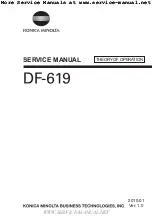
Operator's guide:
1)Unpacking instructions
2)Cleaning of the internal tank
3)External cleaning
4)Drip trays
5)Connection to the water supply
6)Connection to the mains
7)Controls
8)Checking correct functioning
9)Internal cleaning
10)Water level tank
1)Cleaning the condenser
2)Access to the motor compartment
Maintenance manual (Page 48):
3)Wiring diagram diagram of refrigeration unit
!
I
UK
D
E
F
NL
P
S
DK
FIN
B
GR
CZ
EE
LV
LT
H
M
PL
SK
SLO
6
Operator's guide
WARNINGS
It is most important that this instruction booklet is kept together with the appliance both for future
reference and for reasons of safety.
1
. Adults should operate this appliance only. Do not allow children to use the controls or play with it.
2
3
4
5
6
7
. It
is forbidden to modify in any way the main functions and characteristics of this appliance. . The
electrical installation of the appliance should be carried out by a qualified electrician or other competent
person. . Never attempt to carry out repairs unassisted. Inexpert repairs can cause serious damage and
malfunction. . Assistance has to be provided by an authorized engineer only. Always use original spare
parts. . This appliance is not suitable for the storage of basic commodities not including food-stuffs.
. The manufacturers of this appliance accept no responsibility for the consequences of misuse in
contravention of these safety instructions. It further reserves the right to carry out improvements without
prior notice.
8
9
10
11
12
13
. Avoid installing the cabinet directly in line with sunlight. . Nevere install the appliance
near sources of heat, such as radiators, stoves, etc.
. Keep the ventilation grills free from obstruction
for at least 30 cm.
. Ensure that the products displayed on the shelves and grills do not hang over the
edges.
. If damp air or products to be refrigerated should cause ice to form on the evaporator, we
recommend stopping the compressor and placing the goods in special refrigerated containers, kept at the
same temperature, until defrosting is completed;if this is not carried out the compressor will continue to
operate leading to a wasteful consumption of electricity and poor performance.
. If the appliance is not
working and unused, it is indispensable to keep the door open at least 10 cm.
Our products are for internal use only do not install outside restaurants, shops.
1. UNPACKING INSTRUCTIONS
CARDBOARD PACKAGING 1a.
WOODEN CRATE 1b
2.
3
4.
5
6
7
2. CLEANING OF THE INTERNAL TANK
1
2
3.
4.
3. EXTERNAL CLEANING
1.
2.
3
4.
4. DRIP TRAYS
1
2.
NOTICE:
5. CONNECTION TO THE WATER SUPPLY
1.
2
3.
Cut the strip. Remove the cardboard packaging by sliding upwards.
. Remove the nails from the wooden crate with care.
Insert forks of fork-lift truck
between appliance and pallet or crate. . Lift the appliance.
Remove the pallet or crate. . Place the
appliance on a horizontal level surface. . Make sure there is nothing left inside the packaging before
disposal. . Separate the different packaging materials to facilitate disposal (See picture 1).
. Remove the protection film from stainless steel parts. . Clean the tank with a soft sponge and neutral
detergents.
Remove the plastic caps from the drainage holes in the tank to drain off any residual water,
(model Fishing only).
Open the tap on the back of the appliance to eliminate any residual water,
(model Bahia only).
Absolutely refrain from using detergents containing alcohol or derivative products which would
irremediably damage the dome.
Use only a soft dampened sponge. . Clean the wooden surfaces with
special water emulsion-based products, free from solvents, generally available on the market.
Dry with
a clean cloth.
. Remove the protection film from the trays.
Mount the drip trays by resting them on the bottom of the
tank.
For Fishing models, start with the first shelf, positioned centrally, with no holes and with a
central slot (see picture 2).
One end of the water supply pipe, which is situated inside the tank, must be screwed onto the solenoid
valve, and the other end connected to the water supply (A). . One end of the drainage pipe must be
connected to the appliance coupling using a clamp, and the other end to a standard water drain (B).
The mains water should be drinkable, and preferably purified (see picture 3).
FISHING
models
!








































